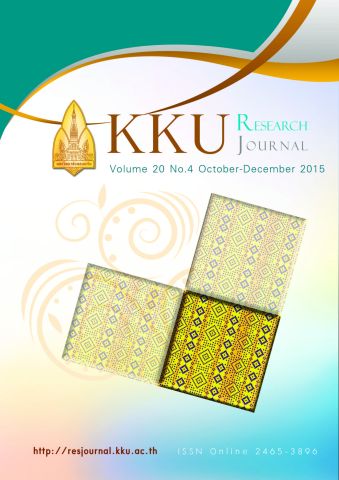The association of HLA and systemic sclerosis (SSc) in the northeastern Thais.
Main Article Content
Abstract
Aim: The majority of Thai SSc patients represent a unique ethnic group found in Northeastern Thailand. Genetic susceptibility may be found in the pathogenesis of Thai SSc patients. This study aims to identify HLA genes which correlate with clinical profiles in these SSc patients.
Methods: Peripheral blood samples were taken from 60 SSc patients diagnosed using the ACR classification 1980 criteria. HLA-A, -B, and -C were analyzed using the PCR-amplification refractory mutation system, and the PCR-sequence specific primer was used for the HLA-DR and- DQ analysis. The distribution of the alleles between SSc patients and the control was found to be significant when it was tested with the corrected P value (<0.05).
Results: Of the 60 SSc patients examined; 66.7% displayed symptoms of diffuse cutaneous SSc (dcSSc), and 33.3% showed limited cutaneous SSc (lcSSc). In the Thai SSc group, the prevalence of HLA DRB1*1502 (allele frequency: AF = 32.5%) and DQB1*0501 (AF = 30.8%) which was significantly higher when compared to the control group (AF = 18.5% and 16.3%) with corrected P value (Pc) = 0.0007 and 0.0001, respectively.
Conclusions: The majority of Thai SSc patients that actually displayed dcSSc, had a high prevalence of internal organ involvement. The results suggest a genetic susceptibility for SSc among the population of Northeastern Thailand, especially for individuals with HLA DRB1*1502. In the West, there is less HLA DRB1*1502, and this factor could explain why dcSSc is more prevalent among the Thai population.
Article Details
References
[2] Olerup O, Aldener A, Fogdell A. HLA-DQB1 and -DQA1 typing by PCR amplification with sequence-specific primers
(PCR-SSP) in 2 hours. Tissue Antigens.1993;41:119–34.
[3] Gelber AC, Manno RL, Shah AA, Woods A, Le EN, Boin F. Race and association with disease manifestations and mortality in scleroderma: a 20-year experience at the Johns Hopkins Scleroderma Center and review of the literature. Medicine (Baltimore).2013;92:191–205.
[4] Kang SH, Park MH, Song EY, Kang SJ, Lee EB, Song YW. Association of HLA class II genes with systemic sclerosis in Koreans. J Rheumatol.2001;28:1577–83.
[5] Takeuchi F, Nakano K, Yamada H, Hong GH, Nabeta H, Yoshida A. Association of HLA-DR with progressive systemic sclerosis in Japanese. J Rheumatol.1994;21:857–63.
[6] Louthrenoo W, Kasitanon N, Wichainun R, Wangkaew S, Sukitawut W, Ohnogi Y. Association of HLA-DRB1*15:02 and DRB5*01:02 allele with the susceptibility to systemic sclerosis in Thai patients. Rheumatol Int. 2013;33:2069–77. [7] Bacher A, Mittoo S, Hudson M, Tatibouet S, Canadian Scleroderma Research Group, Baron M. Systemic sclerosis in Canada’s North American Native population: assessment of clinical and serological manifestations. J Rheumatol. 2013;40:1121–6.
[8] Luo Y, Wang Y, Wang Q, Xiao R, Lu Q. Systemic sclerosis: genetics and epigenetics. J Autoimmun.2013;41:161–7. [9] Beretta L, Rueda B, Marchini M, Santaniello A, Simeón CP, Fonollosa V. Analysis of Class II human leucocyte antigens in Italian and Spanish systemic sclerosis. Rheumatol Oxf Engl. 2012;51: 52–9.
[10] Zhou XD, Yi L, Guo XJ, Chen E, Zou HJ, Jin L.Association of HLA-DQB1*0501 with scleroderma and its clinical features in Chinese population. Int J Immunopathol Pharmacol. 2013;26:747–51.
[11] Wang J, Guo X, Yi L, Guo G, Tu W, Wu W.Association of HLA-DPB1 with scleroderma and its clinical features in Chinese population. PloS One. 2014;9:e87363.
[12] Zhou X, Lee JE, Arnett FC, Xiong M, Park MY, Yoo YK. HLA–DPB1 and DPB2 are genetic loci for systemic sclerosis: A genome-wide association study in Koreans with replication in North Americans. Arthritis Rheum. 2009;60:3807–14. [13] Bossini-Castillo L, Simeon CP, Beretta L, Vonk MC, Callejas- Rubio JL, Espinosa GConfirmation of association of the macrophage migration inhibitory factor gene with systemic sclerosis in a large European population. Rheumatol Oxf Engl.2011;50:1976–81.
[14] Broen JCA, Bossini-Castillo L, van Bon L, Vonk MC, Knaapen H, Beretta L.A rare polymorphism in the gene for Toll-like receptor 2 is associated with systemic sclerosis phenotype and increases the production of inflammatory
m e d i a t o r s . A r t h r i t i s Rheum.2012;64:264–71.

